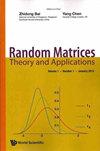Least singular value, circular law, and Lindeberg exchange
IF 0.6
4区 数学
Q4 PHYSICS, MATHEMATICAL
引用次数: 4
Abstract
These lectures cover three loosely related topics in random matrix theory. First we discuss the techniques used to bound the least singular value of (nonHermitian) random matrices, focusing particularly on the matrices with jointly independent entries. We then use these bounds to obtain the circular law for the spectrum of matrices with iid entries of finite variance. Finally, we discuss the Lindeberg exchange method which allows one to demonstrate universality of many spectral statistics of matrices (both Hermitian and non-Hermitian). 1. The least singular value This section1 of the lecture notes is concerned with the behaviour of the least singular value σn(M) of an n × n matrix M (or, more generally, the least nontrivial singular value σp(M) of a n×p matrix with p 6 n). This quantity controls the invertibility of M. Indeed, M is invertible precisely when σn(M) is non-zero, and the `2 operator norm ‖M‖op of M−1 is given by 1/σn(M). This quantity is also related to the condition number σ1(M)/σn(M) = ‖M‖op‖M‖op of M, which is of importance in numerical linear algebra. As we shall see in Section 2, the least singular value of M (and more generally, of the shifts 1 √ n M− zI for complex z) will be of importance in rigorously establishing the circular law for iid random matrices M. The least singular value2 σn(M) = inf ‖x‖=1 ‖Mx‖, which sits at the “hard edge” of the spectrum, bears a superficial similarity to the operator norm ‖M‖op = σ1(M) = sup ‖x‖=1 ‖Mx‖ 2010 Mathematics Subject Classification. Primary 60B20; Secondary 60F17.最小奇异值,循环定律,和林德堡交换
这些讲座涵盖了随机矩阵理论中三个松散相关的主题。首先,我们讨论了用于约束(非厄米)随机矩阵的最小奇异值的技术,特别关注具有联合独立条目的矩阵。然后,我们利用这些界得到了有限方差的iid项矩阵谱的循环律。最后,我们讨论了Lindeberg交换方法,它允许人们证明矩阵(厄米和非厄米)的许多谱统计量的通用性。1. 本讲义第1节讨论一个n× n矩阵M的最小奇异值σn(M)的性质(或者更一般地说,一个p为6n的n×p矩阵的最小非平凡奇异值σp(M))。这个量控制着M的可逆性。事实上,当σn(M)不为零时,M是精确可逆的,并且M - 1的' 2算子范数‖M‖op由1/σn(M)给出。该量还与M的条件数σ1(M)/σn(M) =‖M‖op‖M‖op有关,在数值线性代数中具有重要意义。第2节中我们将看到,M的最小奇异值(和更普遍,1√n M−转移子对于复杂z)将在严格的重要性建立循环法iid随机矩阵M .最奇异value2σn (M) =正为x为= 1为Mx为,坐落在光谱的“硬边”,熊表面相似算子范数为M为op =σ1 (M) =一口为x为= 1为Mx为2010数学主题分类。主要60 b20;二次60 f17。
本文章由计算机程序翻译,如有差异,请以英文原文为准。
求助全文
约1分钟内获得全文
求助全文
来源期刊

Random Matrices-Theory and Applications
Decision Sciences-Statistics, Probability and Uncertainty
CiteScore
1.90
自引率
11.10%
发文量
29
期刊介绍:
Random Matrix Theory (RMT) has a long and rich history and has, especially in recent years, shown to have important applications in many diverse areas of mathematics, science, and engineering. The scope of RMT and its applications include the areas of classical analysis, probability theory, statistical analysis of big data, as well as connections to graph theory, number theory, representation theory, and many areas of mathematical physics.
Applications of Random Matrix Theory continue to present themselves and new applications are welcome in this journal. Some examples are orthogonal polynomial theory, free probability, integrable systems, growth models, wireless communications, signal processing, numerical computing, complex networks, economics, statistical mechanics, and quantum theory.
Special issues devoted to single topic of current interest will also be considered and published in this journal.
 求助内容:
求助内容: 应助结果提醒方式:
应助结果提醒方式:


